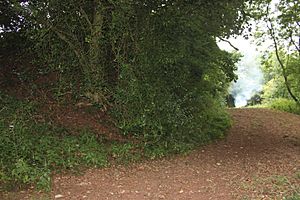King's Castle, Wiveliscombe facts for kids
Quick facts for kids King's Castle |
|
|---|---|

Earthwork at King's Castle Hillfort
|
|
| Location | Wiveliscombe, Somerset, England |
| OS grid reference | ST 096 282 |
| Built | During the Stone Age |
| Architectural style(s) | British pre-Roman Architecture |
| Official name: King's Castle | |
| Designated | July 7, 1999 |
| Reference no. | 188200 |
| Lua error in Module:Location_map at line 420: attempt to index field 'wikibase' (a nil value). | |
King's Castle is an ancient place called a Neolithic hillfort. It is found about 1 kilometer (0.6 miles) east of Wiveliscombe in Somerset, England. A hillfort is like a very old, fortified village or settlement built on top of a hill.
This special site was protected by two large banks of earth. There was also a ditch dug between these banks. The inner wall of earth was quite tall, reaching up to 2.5 meters (8.2 feet) high. The outer wall was a bit shorter, about 1.5 meters (4.9 feet) high.
Archaeologists, who study old things, have found many interesting items at King's Castle. They discovered Arrowheads, scrapers, and borers. These tools tell us about the people who lived there long ago. A big treasure was also found: a pot buried about 0.3 meters (1 foot) deep. Inside this pot were 1139 ancient coins!
Sadly, King's Castle has been damaged over time. People have used the area for quarrying, which means digging out stone or earth. Farmers have also used the land for ploughing, which means turning over the soil. These activities have changed the original shape of the hillfort.
What is a Hillfort?
A hillfort is a type of ancient settlement or fort. It was built on a hill or raised ground. People in the past chose hills because they offered a good view of the surrounding land. This made it easier to spot anyone approaching.
These forts were usually surrounded by large earthworks. These earthworks included banks (raised mounds of earth) and ditches (trenches). They acted like strong walls to protect the people living inside.
When Were Hillforts Built?
Most hillforts in Britain were built during the Late Bronze Age and Early Iron Age. This was roughly around the start of the first millennium BC (about 3,000 years ago). People continued to use and build them for many centuries.
Why Were Hillforts Built?
Historians and archaeologists have different ideas about why hillforts were built. It's a topic they still discuss!
- For Protection: Some experts think hillforts were military sites. They might have been built to protect against attacks from other groups or invaders.
- For Community: Others believe they were more like important community centers. They could have been places where people gathered for trade, meetings, or religious ceremonies.
- Because of Changes: A popular idea is that changes in society led to their creation. When people started using iron more, it changed how goods were traded. This might have caused some social tensions. Hillforts could have offered a safe place during these times.
Archaeologist Barry Cunliffe believes that as the population grew, there was more pressure on resources like food and land. He thinks hillforts provided a safe place for communities. They were like strongholds that could be used if tensions led to fighting. He suggests they weren't always built because of war, but they were useful for defense when needed.
King's Castle is a great example of these amazing ancient structures. It helps us learn about how people lived and protected themselves thousands of years ago.

